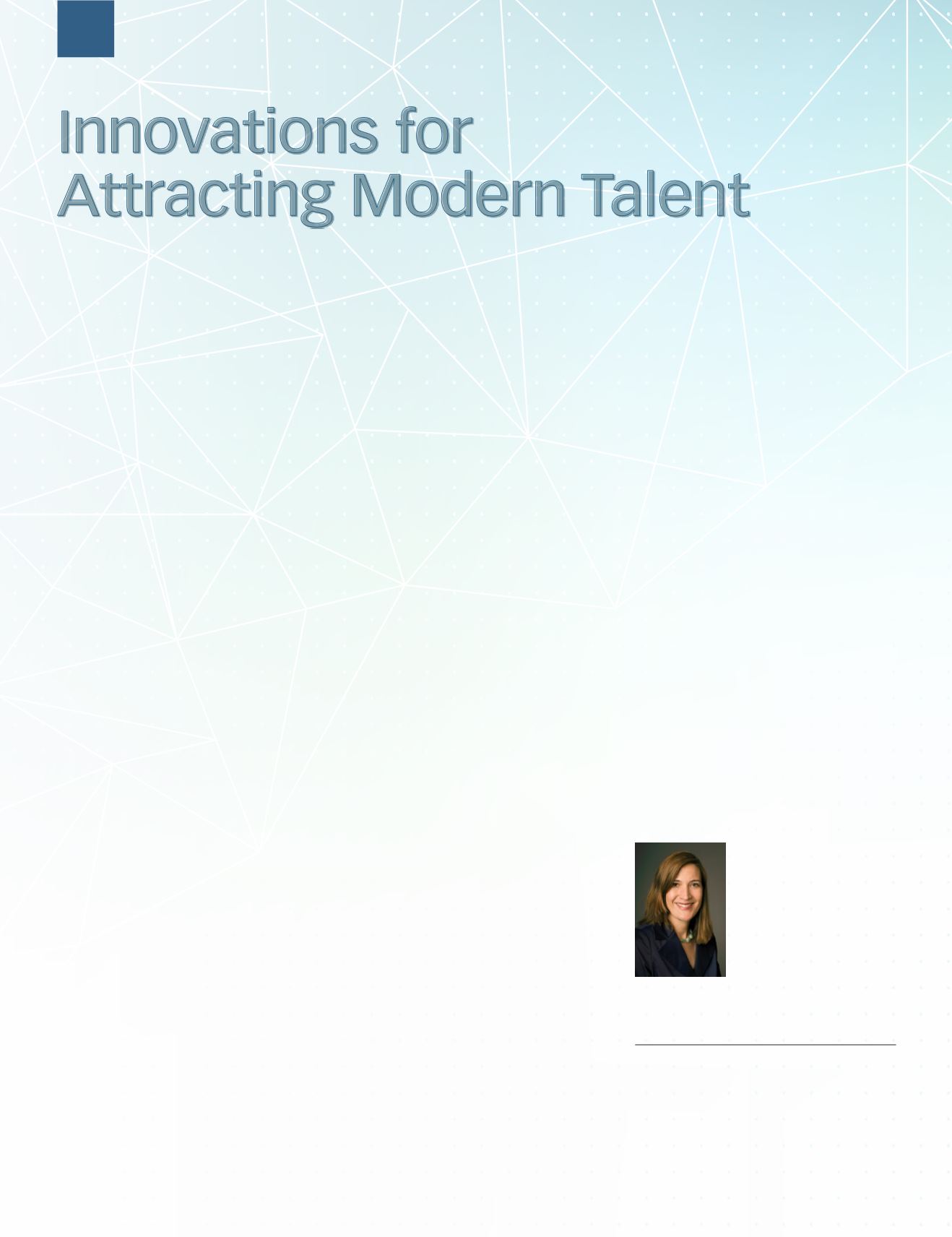
10
HR
West
®
Recruiting
Innovations for
Attracting Modern Talent
By Jeanne MacDonald
The U.S. economy is continuing to look particularly positive this year, and with further growth expected at a rate
of 2.6 percent
1
, 2015 continues to present a sizable opportunity for businesses to expand. But key to maximizing
this opportunity is having the workforce to drive and support desired growth. A highly skilled, motivated and
well-structured workforce is pivotal to achieving the unique business goals of every organization.
I
n response, HR departments are developing
recruitment strategies in line with the latest
technological innovations and shifting business
priorities. These changes have led to several new
trends emerging. Following are those pivotal to
talent management in 2015.
1. IoT – The Internet of Talent
Data is already recognized as one of the most
valuable sources of intelligence. By grasping the
power of this data, ROI can be achieved, data
based on experience, attributes, strengths and
key skills can be made at the recruitment level,
helping to identify best in class talent and suitably
placing them within an organization. This will
also provide benefits in the long term as internal
talent can be restructured during times of growth
or shifted focus by utilizing the talent data kept
within the business.
2. Location, location, location
Location is an important factor for many on
the hunt for new employment opportunities.
Businesses should allow active candidates to
filter job opportunities based on where they are
located, or want to be relocated, creating visual
and engaging job searches using interactive, geo-
location maps.
Additionally, business’s digital platforms must
work harder to identify and engage local talent.
We recently worked with a large American
grocery manufacturing organization on its
sourcing strategy for hiring talent for one of its
offices in Chicago. Through user generated
content on mobile phones, the organization was
able to showcase the benefits the area had to
offer from the point of view of existing employees,
allowing it to increase conversion rates.
3. The mobile and video revolution
There is no doubt that the surge in mobile
and video platforms have changed the way
we interact, both in and out of work. This is
especially true when it comes to recruitment as
the use of technology solutions has advanced
rapidly, largely to meet demand from candidates
for companies to “meet them where they live.”
This is increasingly on mobile devices with
research showing almost 50 percent of job
seekers globally are searching and applying for
jobs this way
2
.
Hiring strategies also need to be digital first.
Dialogues can be created across a wide range of
platforms and channels in order to communicate
with today’s top talent. These platforms do not
end at mobile; video can also be fully integrated
into the recruitment process. We’ve seen a rise
in brands embracing instant video platforms
such as Vine to engage the graduate community,
encouraging prospective candidates to upload
their comments to win challenges and prizes.
Gamification is closely linked with mobile and
video and is becoming increasingly more
important for both a more dynamic candidate
experience and also for candidates to quickly filter
themselves in or out of the recruitment process.
4. Bespoke recruiting
As demonstrated with the shift to mobile and
video, the number of channels now available to
reach brands is rapidly increasing. This allows
brands to now reach prospective candidates
via the channel which is most effective to them.
The role, level and industry the type of candidate
businesses are looking to attract needs to be
carefully evaluated in order to then determine the
best measures to reach them.
Global organizations operating with a global
versus multi-country strategy, also need to be
especially careful not adopt a one-size fits all
talent management model as in different markets
the maturity, priorities and specific cultural
nuances of candidates significantly shifts.
It is clear to see that the talent management
landscape is evolving, with many of these trends
already established practices across businesses
globally. But businesses now need to focus their
energy, budgets and resources internally to develop
and execute a concrete recruitment and talent
management strategy for the year ahead. Over the
next 12 months we expect to see talent acquisition
professionals and HR functions embrace the
various innovations available to not only to extend
their talent pool, but to enhance their employer
brand to create a functional and memorable
candidate experience.
HR
Jeanne MacDonald is the
President of Global Talent
Solutions for Futurestep.
Futurestep’s solutions business,
which includes RPO, Projects
and Consulting services, sees
Jeanne responsible for business
development, solution design,
technology architecture and services, talent advisory
services, and service execution strategy.
1
The Conference Board - Global Economic
Outlook 2015 - Key Findings
/
2
Indeed,
/


